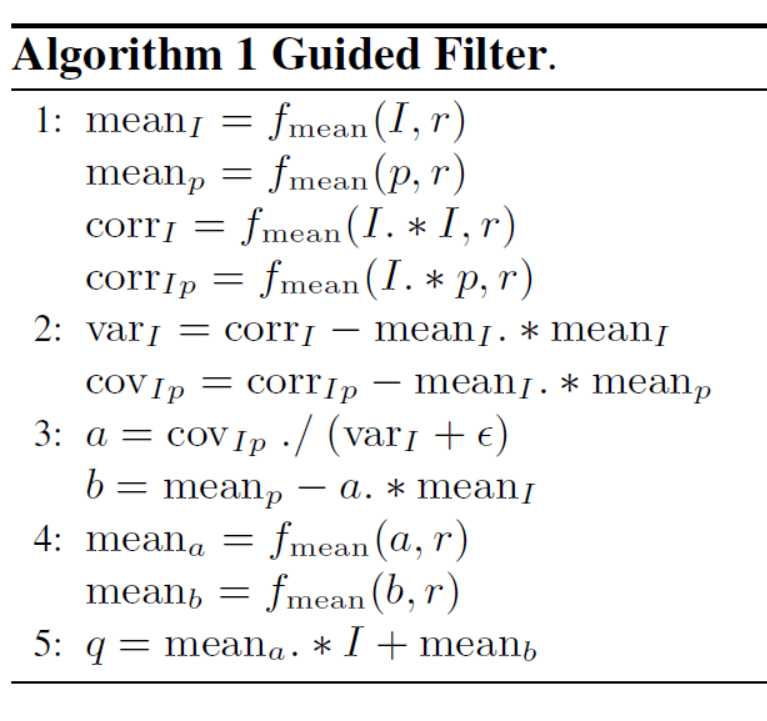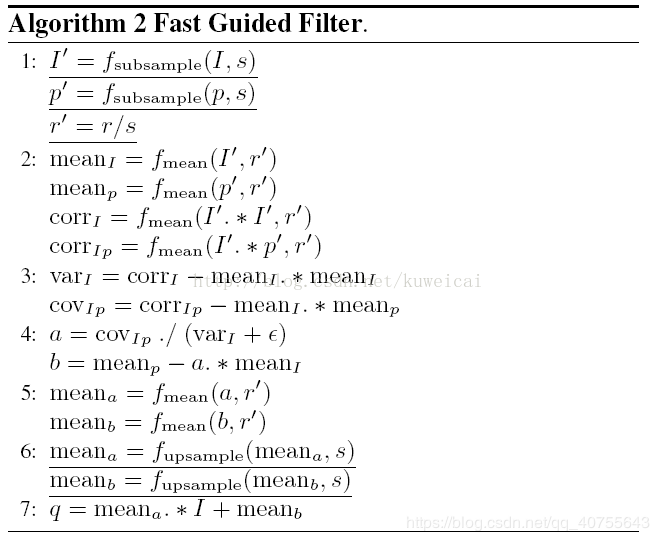1
2
3
4
5
6
7
8
9
10
11
12
13
14
15
16
17
18
19
20
21
22
23
24
25
26
27
28
29
30
31
32
33
34
35
36
37
38
39
40
41
42
43
44
45
46
47
48
49
50
51
52
53
54
55
56
57
58
59
60
61
62
63
64
65
66
67
68
69
70
71
72
73
74
75
76
77
78
79
80
81
82
83
84
85
86
87
88
89
90
91
92
93
94
95
96
97
98
99
100
101
102
103
104
105
106
107
108
109
110
111
112
113
114
115
116
117
118
119
120
121
122
123
124
|
"""
@author: Dragon Liu
Operating environment: Python 3.7.1
lib: opencv-python
Date: 2020/3/22
BUG: 时间复杂度O(m*n*div*r*r),不可行,另外存在img[]访问问题
"""
import math
import cv2
import numpy as np
import matplotlib.pyplot as plt
def gr(px, py, qx, qy, dr):
nut = math.exp( - ( pow((qx - px), 2) + pow((qy - py), 2) ) )
det = 2 * pow(dr, 2)
result = nut / det
return result
def gzeta(guide_img, div, px, py, qx, qy, dzeta):
guide_img = guide_img
nut = math.exp( - ( pow( ( guide_img[px, py, div] - guide_img[qx, qy, div] ), 2 ) ) )
det = 2 * pow(dzeta, 2)
result = nut / det
return result
def GS(image, r, dr, px, py, div):
Upsilon = 0
output = 0
for i in range(r, -(r+1), -1):
for j in range(r, -(r+1), -1):
Upsilon = Upsilon + gr(px, py, px + i, py + j, dr)
output = output + gr(px, py, px + i, py + j, dr) * image[px + i,py + j,div]
output = output / Upsilon
return output
def medbox(img, x, y, div, length, width):
nums = []
length = width = 3
for i in range(math.floor(length/2), -math.floor(length/2)-1, -1):
for j in range(math.floor(width/2), -math.floor(width/2)-1, -1):
nums.append( img[x+i, y+j, div])
return np.median(nums)
def WGGF(guide_img,source,r,dzeta,px,py,div, lam):
guide_img = guide_img
source = source
Upsilon = 0
output = 0
flag = 0
for i in range(r, -(r+1), -1):
for j in range(r, -(r+1), -1):
temp = abs( guide_img[px + i, py + 1, div] - guide_img[px, py, div] )
if temp <= lam:
flag = flag + 1
Upsilon = Upsilon + gzeta(guide_img, div, px, py, px+i, py+j, dzeta)
output = output + guide_img[px + i,py + j,div] * gzeta(guide_img, div, px, py, px+i, py+j, dzeta)
if flag == 1 or Upsilon == 0:
output = medbox( source, px, py, j, 3, 3 )
else:
output = output / Upsilon
return output
def main():
img = cv2.imread('02.png', 1)
source = cv2.cvtColor(img, cv2.COLOR_BGR2RGB)
source = source / 255.0
guide_img = source
print(1.666)
[m ,n, div] = np.shape(source)
r = 5
dr = 0.5
guide_img = cv2.GaussianBlur(source, (r,r), dr)
print(2.666)
target = guide_img
r = 5
dzeta = 0.1
lam = 0.12
num = 0
for k in range(div):
for i in range(m):
for j in range(n):
if i <= r or i >= m - r or j <= r or j >= n - r:
continue
else:
target[i, j, k] = WGGF(guide_img, source, r, dzeta, i, j, k, lam)
num = num + 1
print(num)
print(3.666)
titles = ['Source Image', 'WGGF Image']
images = [source*255.0, target*255.0]
for i in range(2):
plt.subplot(1, 2, i+1), plt.imshow(images[i], 'gray')
plt.title(titles[i])
plt.xticks([]),plt.yticks([])
plt.show()
if __name__ == '__main__':
main()
|


